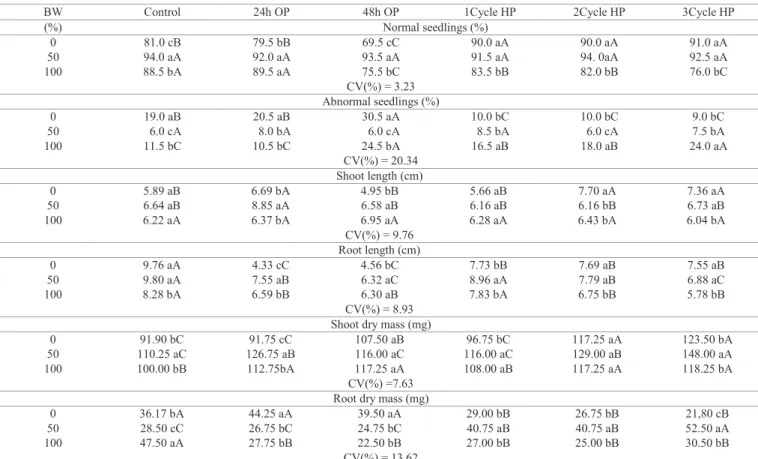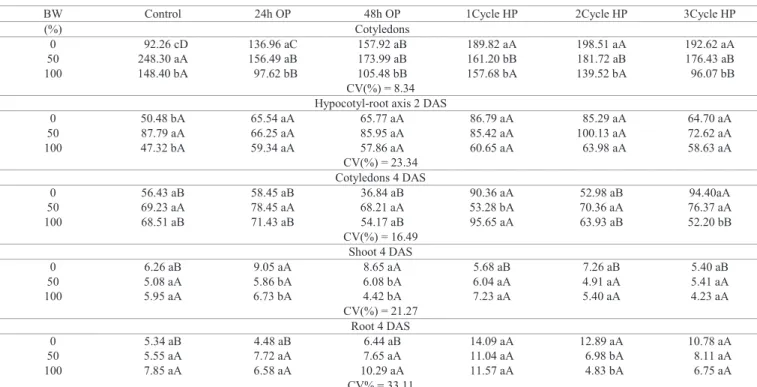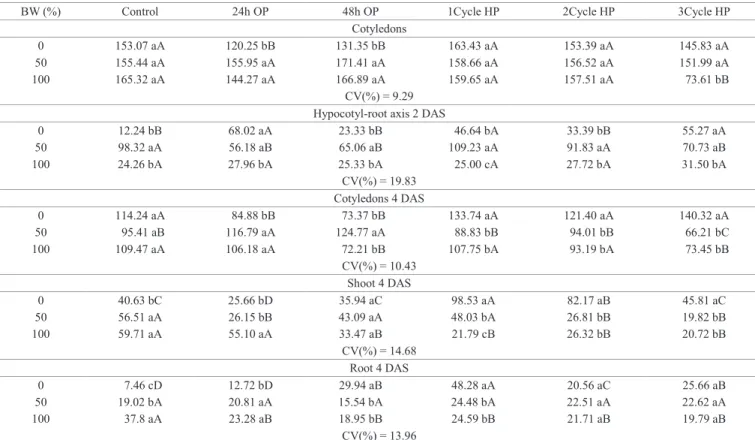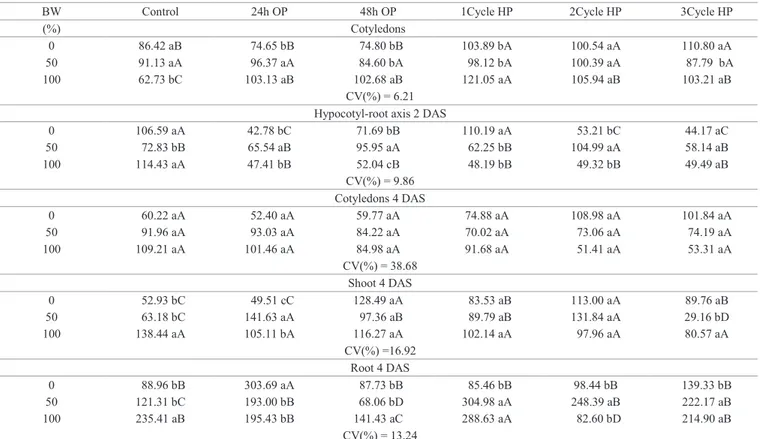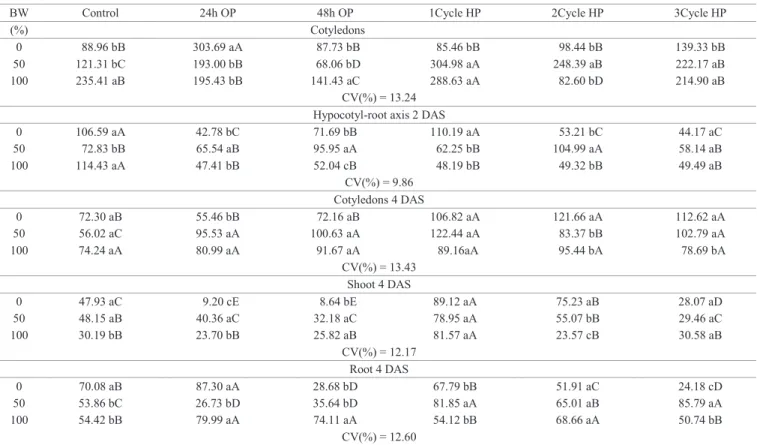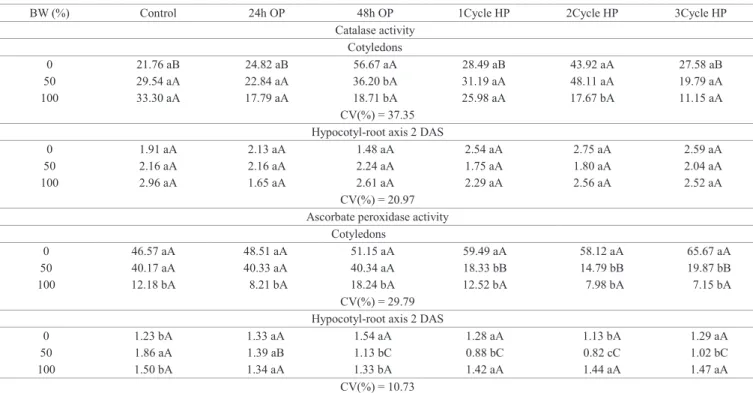Physiological changes in osmo and hydroprimed cucumber
seeds germinated in biosaline water
Janete Rodrigues Matias
2, Renata Conduru Ribeiro
2, Carlos Alberto Aragão
3,
Gherman Garcia Leal Araújo
2, Bárbara França Dantas
2*ABSTRACT- Biosaline agriculture has been a viable alternative for agricultural production in regions with lack of good quality water. To enable the cultivation of vegetables in high electrical conductivities, seed priming has been used to increase tolerance to stress caused by use of brackish water. We aimed to evaluate the efficiency of osmo and hydropriming in cucumber seeds cv. Caipira germinated biosaline in water, regarding germination and biochemical changes during the germinative process. The experimental design was totally randomized, with four replications of 50 seeds or 10 seedlings, in a factorial scheme 6x3; with six priming conditions (control, osmopriming during 24 and 48 hours, hydropriming with 1, 2 and 3 cycles of hydration-dehydration) and three biosaline water (fish farming biosaline wastewater) concentrations in distilled water (0, 50 e 100%). We evaluated the kinetics and percentage of germination; germinative metabolism and activity of antioxidant enzymes. According to the results, one hydropriming cycle is faster and more efficient to improve the performance of cucumber seedling in biosaline water and this can be used in substrate for germinating seeds of cucumber cv. Caipira.
Index terms: water reuse, Curcubitaceae, seedling development.
Modificações fisiológicas em sementes de pepino osmo e hidrocondicionadas
germinadas em água biossalina
RESUMO - A agricultura biossalina tem sido uma alternativa viável para a produção agrícola em regiões com escassez de água de boa qualidade. Para possibilitar o cultivo de hortaliças em condutividades elétricas elevadas, o condicionamento fisiológico de sementes tem sido utilizado para aumentar a tolerância destas ao estresse causado pela utilização de água salobra. Objetivou-se avaliar a eficiência do osmo e hidrocondicionamento em Objetivou-sementes de pepino cv. Caipira em água biossalina, quanto à germinação e as modificações bioquímicas durante o processo germinativo. O delineamento foi inteiramente casualizado, com quatro repetições de 50 sementes ou 10 plântulas, em esquema fatorial 6x3; sendo seis condições de condicionamento fisiológico (controle, osmocondicionamento durante 24 e 48 horas; hidrocondicionamento com 1, 2 e 3 ciclos de hidratação e secagem) e três concentrações de água biossalina (água residuária de piscicultura) em água destilada (0, 50 e 100%). Foram avaliados: porcentagem de germinação; crescimento inicial de plântulas; metabolismo germinativo e atividade de enzimas antioxidantes. De acordo com os resultados obtidos pode-se concluir que um ciclo de hidrocondicionamento é mais rápido e eficiente para melhorar o desempenho das plântulas de pepino em água biossalina, que pode ser utilizada no substrato de germinação de sementes de pepino cv. Caipira.
Termos para indexação: reuso de água, Curcubitacea, desenvolvimento de plântulas.
1Submitted on 06/01/2014. Accepted for publication on 09/12/2014. 2Embrapa Semiárido, Caixa Postal 23, 56302-970 - Petrolina, PE, Brasil. 3Departamento de Tecnologia e Ciências Sociais Universidade do Estado da
Bahia, 48900-000 - Juazeiro, BA, Brasil.
*Corresponding author <barbara.dantas@embrapa.br>
Introduction
Worldwide, soil salinity is a problem for agriculture in more than 8 million hectares; wich is 6% for the total agricultural area (Bot et al., 2000).The most serious salinity problems are held in the irrigated arid and semi-arid regions of the world, such as Northeastern Semiarid Region of Brazil. Soil salinity is also a serious problem in areas where groundwater
of high salt content is used for irrigation (FAO, 2014). Because of the serious problems due to water scarcity, the search for alternatives which aims at better utilization of water resources has become extremely important. As an example, Israel has overcome this problem in an economically viable manner, which is the biosaline agriculture, enabling coexistence with water restriction (Rocha et al., 2010).
with efficient crop development and has been effective in salt
affected regions, with use of sea water, brackish groundwater or wastewater (Al-Said et al., 2012). Although biosaline agriculture may be an alternative to crop production, in glycophytes, wich are most of crop species, it causes yield decrease by submitting seeds, transplants and growing plant to salt stress.
A way to increase seeds tolerance to abiotic stress, such as salt stress, is seed priming through various techniques of osmo or hydropriming used effectively in different crops (Sanchéz et al., 1997; Aragão et al., 2002; Azevedo Neto et al., 2005).
The contact of the seed with polyethylene glycol (PEG) solution during osmopriming, allows the occurance of all preparatory processes for seed germination, but prevents radicle emergence (Heydecker et al., 1975). Apparently, imposition of osmotic stress to seeds can induce tolerance to other stresses, including drought and salt tolerance. Primed seeds tend to germinate faster, since these have already started imbibition, requiring less water to complete germination (Mohammadi and Amiri, 2010).
At hydropriming, the amount of water absorbed by seeds is controlled by the length of time it remains in contact with a moist substrate (Farooq et al., 2010) or high relative humidity atmosphere, and subsequent drying. This technique results in increased seed germination and seedling emergence during re-imbibition (Ashraf and Foolad, 2005).
Within this approach, the aim of this work was to evaluate the effect of osmo and hydropriming in cucumber seeds germination (Cucumis sativus L. - Cucurbitaceae) cultivar
Caipira, in fish farming biosaline wastewater.
Material and Methods
This study was carried out in 2012, with cucumber seeds (Cucumis sativus L. – Cucurbitaceae) cultivar Caipira. The experimental design was completely randomized with four replications of 50 seeds in a factorial scheme 6x3, regarding six priming conditions (control, osmopriming for 24 and 48 hours, 1, 2 and 3 cycles of hydropriming) and three biosaline water dilutions in distilled water (0, 50 and 100% of biosaline water).
Osmopriming: seeds were placed in plastic boxes
(gerboxes) on substrate blotter paper, soaked in -1.0 MPa PEG
6000 solution (Villela et al., 1991), at a volume equivalent to 2.5 times the substrate paper weight and kept in germinator for 24 and 48 hours at 25 °C. After these periods, seeds were rinsed in running tap water to remove PEG solution, and dried at laboratory environment.
Hydropriming: was performed on gerboxes adapted with
aluminum sieve with 40 mL of distilled water under the sieve and on it seeds were distributed and maintained for 8 h under laboratory conditions, characterizing hydration of seeds. For dehydration, water was replaced by 32 g silica, equivalent to 40 mL volume, for 12 hours, completing one cycle hydropriming. Three cycles of hydropriming were performed. Before and after each cycle, seeds water content was evaluated (Brasil, 2009).
Biosaline water (BW): after osmo and hydropriming,
seeds were submitted to germination test in three different dilutions of BW in distilled water (0, 50 and 100%), obtained from tanks used for raising Nile tilapia (Oreochromis sp). The chemical characteristic of BW can be observed in Table 1.
Germination and vigor variables accessed: seeds were
evaluated for water content and percentage of normal and abnormal seedlings (Brasil, 2009). Seedlings were evaluated for shoot and root length and dry weight (Nakagawa, 1999).
Evaluation of germinative metabolism: embryo,
cotyledons, shoots and roots were collected from seedlings with 2 and 4 days, and frozen at -80 ° C until extraction. Total protein (TP); total soluble sugars (TSS); reducing sugars (RS); total amino acids (AA); catalase (CAT, E.C. 1.11.1.6) and ascorbate peroxidase (APX, EC 1.11.1.11) activities were
quantified according to Ribeiro-Reis et al. (2012).
Statistical analysis: all data were subjected to analysis of variance and means were compared by Scott-Knott test at 5% probability.
Results and Discussion
During hydropriming cycles, cucumber seeds water content ranged from 15% after hydration to 5% after dehydration. Water content of osmoprimed seeds reached values around 27% and decreased to 7%, after drying, at both periods of osmopriming.
Table 1. Chemical characteristics of biosaline water (BW).
Cations Anions pH CE
Ca2+ Mg2+ Na+ K+ + CO3
2-HCO3- SO42- Cl-
-mmolc/L dS.m
-1
9.57 22.0 20.2 0.54 52.4 0 2 1.9 56 56.9 6.74 4.94
The germination process of cucumber cv. Caipira seeds was not affected by increasing salt concentration in germination medium. This also occurred in watermelon seeds cv. Crimson Sweet when subjected to domestic saline wastewater (Mota et
al., 2011) or in squash and pumpkin seeds with fish farming
brackish wastewater (Silva et al., 2014).
Although, a 4.94 dS.m-1 electrical conductivity was
formerly considered damaging to Cucurbitaceae (Maas and Hoffman, 1977), recent literature showed cucumber seeds are tolerant up to 22 dS.m-1 (Torres et al., 2000) and over 90% of
cv. Caipira seeds germinate at 14 dS.m-1 (Matias et al., 2014).
Low electrical conductivities can induce an increased germination percentage and decreased number of abnormal seedlings by reducing seed damage by imbibition (Matthews and Powell, 2006). Thus, cucumber cv. Caipira seeds subjected to 50% BW showed a higher percentage of normal seedlings when compared to seeds germinated in distilled water and subjected to a 100% BW. Furthermore, 100% BW induced an increase in cucumber seedlings root dry mass. In the highest salinity (100% BW), there
was dry mass accumulation in shoots compared to roots, emphasizing that salinity does not interfere with the growth of these seedlings (Table 2).
In general, cycles of hydropriming increased normal seedlings percentage when seeds germinated in distilled
water (Table 2). Agreeing with these findings, one cycle of hydropriming was efficient to speed up and increase
germination in cucumber cultivars Hatuey-1 and Japonés (Sanchez et al., 1997). In bean cv. Carioca seeds, hydropriming also was favorable, providing a faster germination (Aragão et al., 2002). Additionally, two and three cycles of hydropriming increased shoots dry mass in 100% BW, compared to other priming treatments (Table 2).
When cucumber seeds were primed for 24 hours, seedlings had higher shoot length growth when subjected to biosaline water, compared to other priming treatments. Evaluating shoot: root length ratio, all priming treatments increased shoot growth, when compared to unprimed seedlings. On the other hand, seeds hydro and osmopriming inhibited growth in root length of cucumber seedlings (Table 2).
Table 2. Germination and vigor of cucumber seedlings cv. Caipira germinated in different percentages of water biosaline (BW) and subjected to osmopriming for 24 and 48 hours (OP) and three cycles hydropriming (HP).
BW Control 24h OP 48h OP 1Cycle HP 2Cycle HP 3Cycle HP
(%) Normal seedlings (%)
0 81.0 cB 79.5 bB 69.5 cC 90.0 aA 90.0 aA 91.0 aA
50 94.0 aA 92.0 aA 93.5 aA 91.5 aA 94. 0aA 92.5 aA
100 88.5 bA 89.5 aA 75.5 bC 83.5 bB 82.0 bB 76.0 bC
CV(%) = 3.23 Abnormal seedlings (%)
0 19.0 aB 20.5 aB 30.5 aA 10.0 bC 10.0 bC 9.0 bC
50 6.0 cA 8.0 bA 6.0 cA 8.5 bA 6.0 cA 7.5 bA
100 11.5 bC 10.5 bC 24.5 bA 16.5 aB 18.0 aB 24.0 aA
CV(%) = 20.34 Shoot length (cm)
0 5.89 aB 6.69 bA 4.95 bB 5.66 aB 7.70 aA 7.36 aA
50 6.64 aB 8.85 aA 6.58 aB 6.16 aB 6.16 bB 6.73 aB
100 6.22 aA 6.37 bA 6.95 aA 6.28 aA 6.43 bA 6.04 bA
CV(%) = 9.76 Root length (cm)
0 9.76 aA 4.33 cC 4.56 bC 7.73 bB 7.69 aB 7.55 aB
50 9.80 aA 7.55 aB 6.32 aC 8.96 aA 7.79 aB 6.88 aC
100 8.28 bA 6.59 bB 6.30 aB 7.83 bA 6.75 bB 5.78 bB
CV(%) = 8.93 Shoot dry mass (mg)
0 91.90 bC 91.75 cC 107.50 aB 96.75 bC 117.25 aA 123.50 bA
50 110.25 aC 126.75 aB 116.00 aC 116.00 aC 129.00 aB 148.00 aA 100 100.00 bB 112.75bA 117.25 aA 108.00 aB 117.25 aA 118.25 bA
CV(%) =7.63 Root dry mass (mg)
0 36.17 bA 44.25 aA 39.50 aA 29.00 bB 26.75 bB 21,80 cB
50 28.50 cC 26.75 bC 24.75 bC 40.75 aB 40.75 aB 52.50 aA
100 47.50 aA 27.75 bB 22.50 bB 27.00 bB 25.00 bB 30.50 bB
CV(%) = 13.62
Table 3. Content of total protein (μg.g-1 of fresh weight) in cucumber seedlings cv. Caipira of 2 and 4 days after sowing (DAS),
germinated in different percentages of biosaline water (BW) and subjected to osmopriming for 24 and 48 hours (OP) and three cycles hydropriming (HP).
Although fish farming effluents induce root growth in
seedlings of cucurbits (Medeiros et al., 2010), cucumber seedlings that developed in BW with electrical conductivity of 4.9 dS.m-1, showed decreased root length (Table 2), as did
gherkin seedlings in electrical conductivities greater than 2.15 dS.m-1 (Oliveira et al., 2013).
Substrate salinity initially changes absorption of water and nutrients, as well as, membrane permeability. By analyzing plant characteristics, one can realize that tolerance to salinity varies with stage of development in which the plant is in and if stress is imposed on a cell, a tissue or an organ of the individual. Cucumber seeds and seedlings showed different degrees of tolerance between organs and developmental stages (Table 2).
Conus et al. (2009) described salinity tolerance as the ability of plants to avoid, through an osmotic regulation, excessive amount of salt of substrate from reaching the plasma and to tolerate toxic and osmotic effects associated with increased salt concentration. Under stress conditions when seeds are primed, germination performance in adverse situation is favored, since seeds have already started soaking with lower osmotic potential and require less water to complete germination (Carvalho and Nakagawa, 2012). Due to a possible osmotic adjustment, which is a reduction of cell osmotic potential by accumulating compatible organic
solutes with metabolism, seed priming has been considered an important enhancer of tolerance to salt and drought stress in plants (Azevedo Neto et al., 2005).
Accumulation of organic solutes, compatible with plant metabolism is an important mechanism of salt tolerance in plants. This mechanism promotes reduction of cell osmotic potential, thereby allowing an osmotic adjustment to the stress condition (Azevedo Neto et al., 2005), which may have occurred in cucumber cv. Caipira seedlings invigorated with hydropriming and subjected to salinity conditions during post-germinative growth (Tables 2-6).
Total protein (TP) in cotyledons, of cucumber seedlings
with two days after sowing (DAS), increased significantly
when they were not preconditioned and germinated in solutions of 50% BW (Table 3). This result was also observed in the hypocotyl-root axis. In 2 DAS cotyledons, under ideal
conditions, the cycles of hydropriming caused a significant
increase in TP concentration.
Mobilization of TP to the seedlings axis was affected by pre-treatments only in ideal germination conditions (0% BW). Under these conditions, hydropriming induced a higher content in shoot TP, while osmopriming induced accumulation in roots TP content (Table 3). BW reduced TP degradation in cucumber cotyledons (Table 3).
BW Control 24h OP 48h OP 1Cycle HP 2Cycle HP 3Cycle HP
(%) Cotyledons
0 92.26 cD 136.96 aC 157.92 aB 189.82 aA 198.51 aA 192.62 aA 50 248.30 aA 156.49 aB 173.99 aB 161.20 bB 181.72 aB 176.43 aB 100 148.40 bA 97.62 bB 105.48 bB 157.68 bA 139.52 bA 96.07 bB
CV(%) = 8.34 Hypocotyl-root axis 2 DAS
0 50.48 bA 65.54 aA 65.77 aA 86.79 aA 85.29 aA 64.70 aA
50 87.79 aA 66.25 aA 85.95 aA 85.42 aA 100.13 aA 72.62 aA
100 47.32 bA 59.34 aA 57.86 aA 60.65 aA 63.98 aA 58.63 aA
CV(%) = 23.34 Cotyledons 4 DAS
0 56.43 aB 58.45 aB 36.84 aB 90.36 aA 52.98 aB 94.40aA
50 69.23 aA 78.45 aA 68.21 aA 53.28 bA 70.36 aA 76.37 aA
100 68.51 aB 71.43 aB 54.17 aB 95.65 aA 63.93 aB 52.20 bB
CV(%) = 16.49
Shoot 4 DAS
0 6.26 aB 9.05 aA 8.65 aA 5.68 aB 7.26 aB 5.40 aB
50 5.08 aA 5.86 bA 6.08 bA 6.04 aA 4.91 aA 5.41 aA
100 5.95 aA 6.73 bA 4.42 bA 7.23 aA 5.40 aA 4.23 aA
CV(%) = 21.27 Root 4 DAS
0 5.34 aB 4.48 aB 6.44 aB 14.09 aA 12.89 aA 10.78 aA
50 5.55 aA 7.72 aA 7.65 aA 11.04 aA 6.98 bA 8.11 aA
100 7.85 aA 6.58 aA 10.29 aA 11.57 aA 4.83 bA 6.75 aA
CV% = 33.11
Both 2 and 4 DAS cotyledons of seedlings which were osmoprimed and germinated in distilled water showed a lower content of amino acids (AA) compared to other pretreatments. This content increased when osmoprimed seedlings were subjected to biosaline water (Table 4). During germination process, synthesis of new proteins relies on provision of adequate amino acids derived from breakdown of storage proteins (Kim et al., 2011). Furthermore, unprimed 2 DAS seedlings germinated under ideal conditions, showed lower AA content in embryonic axis than other treatments, different
from what occurred in cotyledons (Table 4).
Seedlings with 4 DAS showed the accumulation of amino acids when grown from seeds primed for 24 hours. Seedlings not osmoprimed presented increased AA content, both in shoots and roots, as the concentration of BW increased, reaching values higher than twice in distilled water (Table 4). BW had positive effect on mobilization of seed reserves, which favored germination and seedling performance, leading to a better development in BW (Tables 2-6).
Table 4. Content of total aminoacids (μmol.g-1 of fresh weight) in cucumber seedlings cv. Caipira of 2 and 4 days after sowing
(DAS), germinated in different percentages of biosaline water (BW) and subjected to osmopriming for 24 and 48 hours (OP) and three cycles hydropriming (HP).
BW (%) Control 24h OP 48h OP 1Cycle HP 2Cycle HP 3Cycle HP
Cotyledons
0 153.07 aA 120.25 bB 131.35 bB 163.43 aA 153.39 aA 145.83 aA
50 155.44 aA 155.95 aA 171.41 aA 158.66 aA 156.52 aA 151.99 aA
100 165.32 aA 144.27 aA 166.89 aA 159.65 aA 157.51 aA 73.61 bB CV(%) = 9.29
Hypocotyl-root axis 2 DAS
0 12.24 bB 68.02 aA 23.33 bB 46.64 bA 33.39 bB 55.27 aA
50 98.32 aA 56.18 aB 65.06 aB 109.23 aA 91.83 aA 70.73 aB
100 24.26 bA 27.96 bA 25.33 bA 25.00 cA 27.72 bA 31.50 bA
CV(%) = 19.83 Cotyledons 4 DAS
0 114.24 aA 84.88 bB 73.37 bB 133.74 aA 121.40 aA 140.32 aA 50 95.41 aB 116.79 aA 124.77 aA 88.83 bB 94.01 bB 66.21 bC 100 109.47 aA 106.18 aA 72.21 bB 107.75 bA 93.19 bA 73.45 bB
CV(%) = 10.43 Shoot 4 DAS
0 40.63 bC 25.66 bD 35.94 aC 98.53 aA 82.17 aB 45.81 aC
50 56.51 aA 26.15 bB 43.09 aA 48.03 bA 26.81 bB 19.82 bB
100 59.71 aA 55.10 aA 33.47 aB 21.79 cB 26.32 bB 20.72 bB
CV(%) = 14.68 Root 4 DAS
0 7.46 cD 12.72 bD 29.94 aB 48.28 aA 20.56 aC 25.66 aB
50 19.02 bA 20.81 aA 15.54 bA 24.48 bA 22.51 aA 22.62 aA
100 37.8 aA 23.28 aB 18.95 bB 24.59 bB 21.71 aB 19.79 aB
CV(%) = 13.96
Means followed by the same capital letter on the line, and lower case letter in the column do not differ statistically from each other. The Scott-Knott test at 5% probability level was applied.
Among the compounds predominant in seed reserves, carbohydrates act as an energy source in early seedling development (Carvalho and Nakagawa, 2012). Germination in BW, diluted or not, induced a higher content of reducing sugars (RS) in cotyledons of 2 DAS seedlings, except for those which were osmoprimed for 24 hours. Moreover, hypocotyl-root axis in this response was reversed for most pretreatments, in which 4 DAS cotyledons showed lower values RS compared to 2 DAS seedlings. Hydropriming RS resulted in higher levels in cotyledons of seedlings
subjected to distilled water, whereas those maintained in 50% BW showed a high cotyledon RS content in all pretreatments. One cycle of hydropriming caused an increase in RS content in 2 DAS cotyledons and in 4 DAS shoots (Table 5).
in 4 DAS cotyledons was lower compared to 2 DAS cotyledons. The level of TSS was higher in 4 DAS cotyledons of hydroprimed seedlings that developed in distilled water.
BW Control 24h OP 48h OP 1Cycle HP 2Cycle HP 3Cycle HP
(%) Cotyledons
0 86.42 aB 74.65 bB 74.80 bB 103.89 bA 100.54 aA 110.80 aA 50 91.13 aA 96.37 aA 84.60 bA 98.12 bA 100.39 aA 87.79 bA 100 62.73 bC 103.13 aB 102.68 aB 121.05 aA 105.94 aB 103.21 aB
CV(%) = 6.21 Hypocotyl-root axis 2 DAS
0 106.59 aA 42.78 bC 71.69 bB 110.19 aA 53.21 bC 44.17 aC 50 72.83 bB 65.54 aB 95.95 aA 62.25 bB 104.99 aA 58.14 aB 100 114.43 aA 47.41 bB 52.04 cB 48.19 bB 49.32 bB 49.49 aB
CV(%) = 9.86 Cotyledons 4 DAS
0 60.22 aA 52.40 aA 59.77 aA 74.88 aA 108.98 aA 101.84 aA 50 91.96 aA 93.03 aA 84.22 aA 70.02 aA 73.06 aA 74.19 aA 100 109.21 aA 101.46 aA 84.98 aA 91.68 aA 51.41 aA 53.31 aA
CV(%) = 38.68
Shoot 4 DAS
0 52.93 bC 49.51 cC 128.49 aA 83.53 aB 113.00 aA 89.76 aB 50 63.18 bC 141.63 aA 97.36 aB 89.79 aB 131.84 aA 29.16 bD 100 138.44 aA 105.11 bA 116.27 aA 102.14 aA 97.96 aA 80.57 aA
CV(%) =16.92 Root 4 DAS
0 88.96 bB 303.69 aA 87.73 bB 85.46 bB 98.44 bB 139.33 bB 50 121.31 bC 193.00 bB 68.06 bD 304.98 aA 248.39 aB 222.17 aB 100 235.41 aB 195.43 bB 141.43 aC 288.63 aA 82.60 bD 214.90 aB
CV(%) = 13.24
Means followed by the same capital letter on the line, and lower case letter in the column do not differ statistically from each other. The Scott-Knott test at 5% probability level was applied.
In pure BW, all pre-treatments induced increased levels of
TSS, with the most significant increase after one cycle of
hydropriming (Table 6).
Table 5. Content of total soluble sugars (μmol.g-1 of fresh weight) in cucumber seedlings cv. Caipira of 2 and 4 days after
sowing (DAS), germinated in different percentages of biosaline water (BW) and subjected to osmopriming for 24 and 48 hours (OP) and three cycles hydropriming (HP).
Reserve mobilization during germination, which provides energy for formation of the new plant, is a determining factor in seedling vigor produced by the end of the process (Carvalho and Nakagawa, 2012). Thus, during imposition of any stress, mobilization of storage substances of seeds should adjust so that normal, healthy and vigorous seedlings can be formed. In plants subjected to salt stress, accumulation of soluble sugars is a common process in the cells. Sugars have a role in osmotic adjustment, but also have indirect effects of protection as in stabilization of proteins (Bianchi et al., 1991). Priming, by imposing a moderate osmotic stress to seeds, induces the concentration of osmolites, such as sugars, to keep the cell´s osmotic potential compatible with maintenance of stability of cell proteins, minimizing the loss of enzymatic activity or membrane integrity which occurs when there is water or saline stress (Gonçalves et al., 2007).
Catalase (CAT) prevents formation of reactive compounds, converting hydrogen peroxide into water and oxygen, which are non-reactive oxygen species (Nakada et al., 2011).The activity of CAT in the hypocotyl-root axis of 2 DAS seedlings was not affected by either methods of priming imposed on cucumber seeds (Table 7). This means these seeds showed no changes in oxidative stress, and therefore respiratory capacity, energy supply (ATP) and assimilates for seed germination may not be affected (Demirkaya et al., 2010). In 2 DAS cucumber seedlings cotyledons, CAT activity was higher than other treatments only for those who were osmoprimed for 48 hours or hydroprimed for two cycles and germinated in distilled water (Table 7), indicating that in 2 DAS cotyledons BW caused a mild salt stress, which was not alleviated by priming.
BW Control 24h OP 48h OP 1Cycle HP 2Cycle HP 3Cycle HP
(%) Cotyledons
0 88.96 bB 303.69 aA 87.73 bB 85.46 bB 98.44 bB 139.33 bB 50 121.31 bC 193.00 bB 68.06 bD 304.98 aA 248.39 aB 222.17 aB 100 235.41 aB 195.43 bB 141.43 aC 288.63 aA 82.60 bD 214.90 aB
CV(%) = 13.24 Hypocotyl-root axis 2 DAS
0 106.59 aA 42.78 bC 71.69 bB 110.19 aA 53.21 bC 44.17 aC
50 72.83 bB 65.54 aB 95.95 aA 62.25 bB 104.99 aA 58.14 aB
100 114.43 aA 47.41 bB 52.04 cB 48.19 bB 49.32 bB 49.49 aB CV(%) = 9.86
Cotyledons 4 DAS
0 72.30 aB 55.46 bB 72.16 aB 106.82 aA 121.66 aA 112.62 aA
50 56.02 aC 95.53 aA 100.63 aA 122.44 aA 83.37 bB 102.79 aA
100 74.24 aA 80.99 aA 91.67 aA 89.16aA 95.44 bA 78.69 bA CV(%) = 13.43
Shoot 4 DAS
0 47.93 aC 9.20 cE 8.64 bE 89.12 aA 75.23 aB 28.07 aD
50 48.15 aB 40.36 aC 32.18 aC 78.95 aA 55.07 bB 29.46 aC
100 30.19 bB 23.70 bB 25.82 aB 81.57 aA 23.57 cB 30.58 aB
CV(%) = 12.17 Root 4 DAS
0 70.08 aB 87.30 aA 28.68 bD 67.79 bB 51.91 aC 24.18 cD
50 53.86 bC 26.73 bD 35.64 bD 81.85 aA 65.01 aB 85.79 aA
100 54.42 bB 79.99 aA 74.11 aA 54.12 bB 68.66 aA 50.74 bB
CV(%) = 12.60
CAT activity were hardly observed (data not shown), indicating no increase in reactive oxygen species (ROS) or damage to cell
membranes which could influence seedling performance.
The activity of ascorbate peroxidase (APX) in 2 DAS cotyledons was lower in seedlings subjected to 100% BW. Hydropriming in cotyledons induced a reduction in APX activity when subjected to BW. In 2 DAS seedlings hypocotyl-root axis, APX activity was low in relation
to cotyledons. In hypocotyl-root axis of osmoprimed seedlings, APX activity was lower compared to non primed seedlings developed in 50% BW (Table 7) and at 4 DAS the activity was null (data not shown). The decrease of APX activity when seeds were hydroprimed, may have been caused by decreased oxidative stress, resulting in an
insufficient amount of ROS to induce the activity of this
enzyme (Ribeiro-Reis et al., 2012).
Table 6. Content of reducing sugars (μmol.g-1 of fresh weight) in cucumber seedlings cv. Caipira of 2 and 4 days after sowing
(DAS), germinated in different percentages of biosaline water (BW) and subjected to osmopriming for 24 and 48 hours (OP) and three cycles hydropriming (HP).
Means followed by the same capital letter on the line, and lower case letter in the column do not differ statistically from each other. The Scott-Knott test at 5% probability level was applied.
Considering antioxidative enzymes play vital roles in growth and development of early embryos, an increase in activity of these enzymes might result in vigorous growth and good crop establishment. Studies have shown priming affects activity of oxidative enzymes in the germination of seeds of different species (Ashraf and Foolad, 2005). However, not all cultures respond satisfactorily when developing in saline conditions, thus antioxidant defense mechanisms may provide a strategy to increase salt tolerance (Gonçalves et al., 2007).
In the present study, cucumber seedlings have grown satisfactorily in conditions that would be detrimental for the crop. When subjected to priming treatments, cucumber seeds showed higher tolerance to mild salt stress induced by
the biosaline water, reflecting on seedling vigor. This study
Table 7. Catalase- CAT activity (μmol H2O2 min-1.mg protein-1) and ascorbate peroxidase- APX activity (ηmol ascorbate.min-1.
mg proteín-1) in cucumber seedlings cv. Caipira of 2 days after sowing (DAS), germinated in different percentages of
biosaline water (BW) and subjected to osmopriming for 24 and 48 hours (OP) and three cycles hydropriming (HP).
BW (%) Control 24h OP 48h OP 1Cycle HP 2Cycle HP 3Cycle HP
Catalase activity Cotyledons
0 21.76 aB 24.82 aB 56.67 aA 28.49 aB 43.92 aA 27.58 aB
50 29.54 aA 22.84 aA 36.20 bA 31.19 aA 48.11 aA 19.79 aA
100 33.30 aA 17.79 aA 18.71 bA 25.98 aA 17.67 bA 11.15 aA
CV(%) = 37.35 Hypocotyl-root axis 2 DAS
0 1.91 aA 2.13 aA 1.48 aA 2.54 aA 2.75 aA 2.59 aA
50 2.16 aA 2.16 aA 2.24 aA 1.75 aA 1.80 aA 2.04 aA
100 2.96 aA 1.65 aA 2.61 aA 2.29 aA 2.56 aA 2.52 aA
CV(%) = 20.97 Ascorbate peroxidase activity
Cotyledons
0 46.57 aA 48.51 aA 51.15 aA 59.49 aA 58.12 aA 65.67 aA
50 40.17 aA 40.33 aA 40.34 aA 18.33 bB 14.79 bB 19.87 bB
100 12.18 bA 8.21 bA 18.24 bA 12.52 bA 7.98 bA 7.15 bA CV(%) = 29.79
Hypocotyl-root axis 2 DAS
0 1.23 bA 1.33 aA 1.54 aA 1.28 aA 1.13 bA 1.29 aA
50 1.86 aA 1.39 aB 1.13 bC 0.88 bC 0.82 cC 1.02 bC
100 1.50 bA 1.34 aA 1.33 bA 1.42 aA 1.44 aA 1.47 aA
CV(%) = 10.73
Means followed by the same capital letter on the line, and lower case letter in the column do not differ statistically from each other. The Scott-Knott test at 5%
probability level was applied. Data were transformed by the equation X = √ x.
Conclusions
The cucumber seedlings were tolerant to salinity up to 4.9 dS.m-1 imposed by biosaline water (BW).The BW may be used
in germinating seeds of cucumber cv. Caipira and may be a viable alternative use for the production of seedlings through new studies.
One cycle of hydropriming can improve the overall performance of cucumber seedlings.
References
AL-SAID, F. A.; ASHFAQ , M.; AL-BARHI, M.; HANJRA, M.A.; KHAN, I. A. Water productivity of vegetables under modern irrigation methods in Oman. Irrigation and Drainage, v.61, n.4, p. 477-489, 2012. http:// onlinelibrary.wiley.com/doi/10.1002/ird.1644/full.
ARAGÃO, C.A.; DANTAS, B.F.; ALVES, E.; CORRÊA, M.R. Sementes de feijão submetidas a ciclos e períodos de hidratação-secagem. Scientia Agricola, v.59, n.1, p.87-92, 2002. http://www.scielo.br/pdf/sa/v59n1/8079.pdf
ASHRAF, M.; FOOLAD, M.R. Pre-sowing seed treatment - a shotgun approach to improve germination, plant growth, and crop yield under saline and non-saline conditions. Advances in Agronomy, v.88, p.223-271, 2005. http:// ac.els-cdn.com/S006521130588006X/1-s2.0-S006521130588006X-main. pdf?_tid=3fac8852-47b7-11e3-904a-00000aab0f6b&acdnat=1383833992_ e16d08759dccfa0e527a9dd6345849e4
AZEVEDO NETO, A.D.; PRISCO, J.T.; ENEAS-FILHO, J.; MEDEIROS, J.V.R.; GOMES-FILHO, E. Hydrogen peroxide pretreatment induces salt-stress acclimation in maize plants. Journal of Plant Physiology, v.162, p.1114-1122, 2005. http://ac.els-cdn.com/S0176161705000726/1-s2.0-S0176161705000726-main.pdf?_tid=9bc0d724-4875-11e3-9b0d-00000aacb 35f&acdnat=1383915751_9f120673cdc3ff3f5f5c07d869edaae9
BIANCHI, G.; GAMBA, A.; MURELLI, C.; SALAMINI, F.; BARTELS, D. Novel carbohydrate metabolism in the resurrection plant Cratero stigma plantagineum. The Plant Journal, v.1, p. 355-359, 1991. http://onlinelibrary. wiley.com/doi/ 10.1046/j.1365-313X.1991.t01-11-00999.x/pdf
BOT, A.; NACHTERGAELE, F.; YOUNG, A. Land resource potential and constraints at regional and country levels. Rome: FAO, 2000. (FAO.World Soil Resources Report, 90). ftp://ftp.fao.org/agl/agll/docs/wsr.pdf
BRASIL. Ministério da Agricultura, Pecuária e Abastecimento. Regras para análise de sementes. Ministério da Agricultura, Pecuária e Abastecimento. Secretária de Defesa Agropecuária. Brasília: Mapa/ACS, 2009. 395p. http://
www.agricultura.gov.br/arq_editor/file/2946_regras_analise__sementes.pdf
CARVALHO, N. M.; NAKAGAWA, J. Sementes: ciência, tecnologia e produção. 5.ed. Jaboticabal: FUNEP, 2012. 590p.
DEMIRKAYA, M.; DIETZ, K.J.; SIVRITEPE, H.O. Changes in antioxidant enzymes during aging of onion seeds. Notula e Botanica e Hortiagrobotanici, v.38, n.1, p.49-52, 2010. http://www.notulaebotanicae.ro/index.php/nbha/ article/view/4575/4417
FAO - Food and Agriculture Organization of the United Nations, 2014. Soil salinity management. http://www.fao.org/tc/exact/sustainable-agriculture-platform-pilot-website/soil-salinity-management/en/. Accessed on May, 17th, 2014.
FAROOQ, M.; WAHID, A.; AHMAD, N.; ASAD, S.A. Comparative
efficacy of surface drying and re-drying seed priming in rice: changes
in emergence, seedling growth and associated metabolic events. Paddy Water Environmental, v.08, n.01, p.15-22, 2010. http://link.springer.com/ article/10.1007/s10333-009-0170-1#page-1
GONÇALVES, J.F.; BECKER, A.G.; CARGNELUTTI, D.; TABALDI, L.A.; PEREIRA, L.B.; BATTISTI, V.; SPANEVELLO, R.M.; MORSCH, V. M.; NICOLOSO, F.T.; SCHETINGER, M. R.C. Cadmium toxicity causes oxidative stress and induces response of the antioxidant system in cucumber seedlings. Brazilian Journal Plant Physiology, v.19, n.3, p.223-232, 2007. http://www.scielo.br/scielo.php?script=sci_arttext&pid=S1677-04202007000300006&lng=en&nrm=iso
HEYDECKER, W.; HIGGING, J.; TURNER, Y.J. Invigoration of seeds. Seed Science and Technology, v.3, p.881-888, 1975.
KIM, H.T.; CHOI, U.K.; RYU, H.S.; LEE, S.J.; KWON, O.S. Mobilization of storage proteins in soybean seed (Glycine max L.) during germination and seedling growth. Biochimica et Biophysica Acta, v.1814, p.1178-1187, 2011. http://www.ncbi.nlm.nih.gov/pmc/articles/PMC1877431/pdf/ amjpathol00113-0109.pdf8
MAAS, E.V., HOFFMAN, G.J. Crop salt tolerance, current assessment. Journal of the Irrigation and Drainage Division, v.103, n.2, p.115-134, 1977. http://www.waterrights.ca.gov/baydelta/docs/southerndeltasalinity/ hist_exhibits/1977bdh_p2ex1.pdf
MATIAS, J.R.; SILVA, T.C.F.S.; OLIVEIRA, G.M.; ARAGÃO, C.A.; DANTAS,
B.F. Germinação de sementes de pepino cv. Caipira em condições de estresse
hídrico e salino. Revista Sodebras, v.10, n.110, 2014. (in press)
MATTHEWS, S.; POWELL, A.A. Electrical conductivity vigour test: physiological basic and use. ISTA News Bulletin, n.131, p.32-35, 2006. https://www.seedtest.org/upload/cms/user/STI131April2006.pdf
MEDEIROS, D.C.; MARQUES, L.F.; DANTAS, M.R.S.; MOREIRA, J.N.;
AZEVEDO, C.M.S.B. Produção de mudas de meloeiro com efluente de
piscicultura em diferentes tipos de substratos e bandejas. Revista Brasileira de Agroecologia, v.5, n.2, p. 65-71, 2010. http://www.aba-agroecologia.org. br/ojs2/index.php/rbagroecologia/article/view/9619/pdf
MOHAMMADI, G.R.; AMIRI, F.The effect of priming on seed performance of canola (Brassica napus L.) under drought stress. American Eurasian Journal of Agricultural & Environmental Sciences, v.2, n.9, p.202-207, 2010. http://www.idosi.org/aejaes/jaes9%282%29/16.pdf
MOTA, A.F.; ALMEIDA, J.P.N.; SANTOS, J.S.; AZEVEDO, J.; GURGEL, M.T. Desenvolvimento inicial de mudas de melancia ‘Crimson sweet’ irrigadas com águas residuárias. Revista Verde, v.6, n.2, p.98–104, 2011. http://www. gvaa.com.br/revista/index.php/RVADS/article/viewFile/628/pdf_175
NAKADA, P.G.; OLIVEIRA, J.A.; MELO, L.C.; GOMES, L.A.A.; VON
PINHO, E.V.R. Desempenho fisiológico e bioquímico de sementes de pepino
nos diferentes estádios de maturação, Revista Brasileira de Sementes, v.33, n.1,p.113–122, 2011. http://www.scielo.br/pdf/rbs/v33n1/13.pdf
NAKAGAWA, J. Testes de vigor baseados no desempenho das plântulas. In: KRZYZANOSKI, F.C.; VIEIRA, R.D.; FRANÇA-NETO, J.B. (Ed.). Vigor de sementes: conceitos e testes. Londrina: ABRATES, 1999. p.2.1-2.24.
OLIVEIRA, F.N.; TORRES, S.B.; BENEDITO, C.P.; MARINHO, J.C.
Comportamento de três cultivares de maxixe sob condições salinas. Semina: Ciências Agrárias, v.34, n.6, p.2753-2762, 2013. http://www.uel.br/revistas/ uel/index.php/semagrarias/article/view/12015/pdf_122
RIBEIRO-REIS, R.C.; DANTAS, B.F.; PELACANI, C.R. Mobilization of reserves and germination of seeds of Erythrina velutina Willd.(Leguminosae-Papilionoideae) under different osmotic potentials. Revista Brasileira de Sementes, v.34, n.4, p.580-588, 2012. http://www.scielo.br/scielo. php?script=sci_arttext&pid=S0101-31222012000400008&lng =en&nrm=iso
ROCHA, F.A.; SILVA, J.O.; BARROS, F.M. Reuso de águas residuárias
na agricultura: a experiência israelense e brasileira. Enciclopédia Biosfera, v.6, n.11, p.1-9, 2010. http://www.conhecer.org.br/enciclop/2010c/reuso%20 de%20aguas.pdf.
SANCHÉZ, J.A.; CALVO, E.; ORTA, R.; MURILO, Z. Tratamientos
pré-germinativos de hidratación–deshidratación pra semillas de pepino (Cucumis sativus L.). Acta Botánica Mexicana, n.38, p.13-20, 1997. http://www. redalyc.org/pdf/574/57403803.pdf
SILVA, J.E.S.B; BARBOSA, L.G.; SILVA, F.Z.; SILVA, T.B.; MATIAS, J.R.;
ARAGÃO, C.A.; DANTAS, B.F. Produção de mudas de moranga e abóboras
irrigadas com água biossalina. Scientia Plena, v.10, n.10, p.1 - 109906-9, 2014. http://www.scientiaplena.org.br/sp/article/view/1949/1042
TORRES, S.B.; VIEIRA, E.L.; MARCOS-FILHO, J. Efeitos da salinidade na germinação e no desenvolvimento de plântulas de pepino. Revista Brasileira de Sementes, v.22, n.2, p.39-44, 2000.
VILLELA, F.A.; DONI FILHO, L.; SEQUEIRA, E.L. Tabela de potencial
osmótico em função da concentração de polietileno glicol 6000 e da

